The Dell XPS 15 9550 Review: Infinity Edge Lineup Expands
by Brett Howse on March 4, 2016 8:00 AM ESTCompute
The XPS 15 is not marketed as a gaming laptop, and while any gaming laptop can pull double duty, people buying the XPS 15 may not be interested in gaming at all. The GPU can still be leveraged for certain workloads such as photo and video editing. The parallel computing power of the GPU makes it a great choice for these types of tasks.
CompuBench
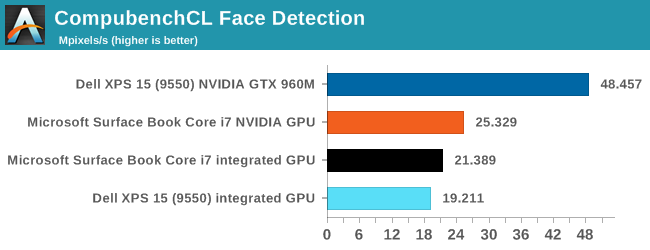
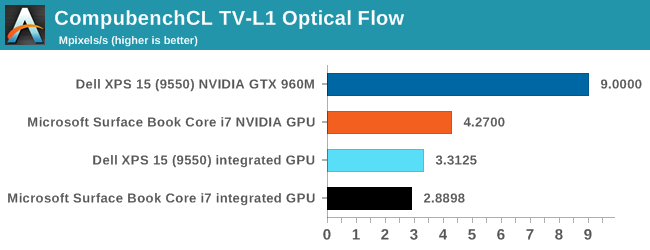
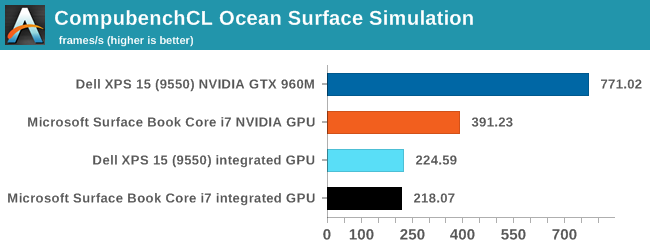
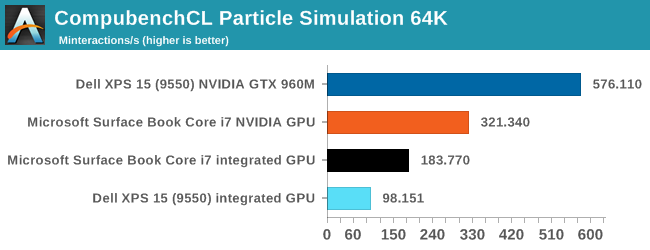
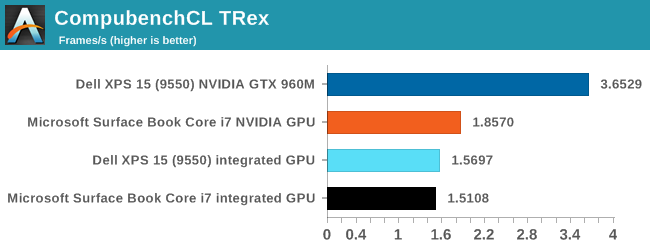

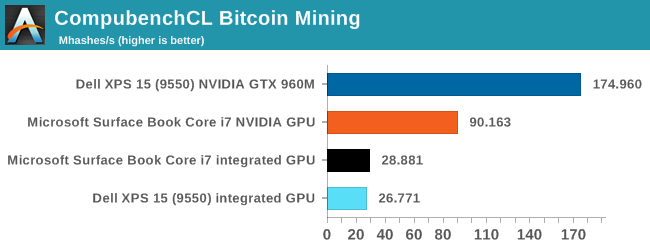
The only other device we’ve tested with Kishonti’s CompuBench is the dGPU version of the Surface Book. I felt it would be a nice comparison to see just how much more performance the GTX 960M would give in compute tasks. Compared to just integrated graphics, there is a big jump in performance from both of the discrete cards, but the GTX 960M is roughly double the performance of the GT 940M in the Surface Book. If you need compute power, you get a lot more in the XPS 15 with the quad-core processor and much more powerful GPU.
Storage Performance
Dell does offer the XPS 15 with a mechanical hard drive as the baseline option, but once you step up a couple of tiers it can be outfitted with a PCIe based SSD, and in the case of our review unit it is the Samsung PM951. This has become incredibly popular it seems, since it lets companies check the box beside PCIe on storage, but unfortunately it is a TLC based drive so write speeds aren't as high as what we've seen MLC-based PCIe drives do. Clearly Samsung is aggressive with the pricing on this drive since it is in pretty much every device we’ve seen that has PCIe storage.
Recently PCMark 8 updated their testing for storage to better differentiate drives with NVMe storage. As such, the existing scores are no longer comparable with those from the new suite. The XPS 15 scored 5036 in the new test, but we'll need more devices tested in order to have something to compare it to.
Despite the TLC NAND, Dell shipped the 512 GB version of the XPS 15, so it has enough NAND dies to help the write speeds through parallel work, keeping even this slower TLC drive performant over short bursts. I actually expected read speeds to be a bit higher as well but over 800 MB/s is still faster than what SATA drives can do.


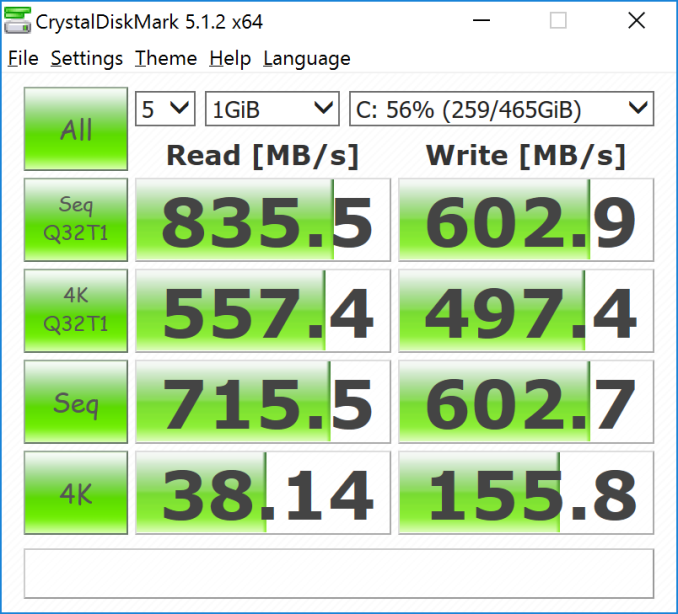








152 Comments
View All Comments
comomolo - Friday, March 4, 2016 - link
I agree with you. It takes little time to make things right. Especially wrong is the picture comparing the size of the XPS 15 to a "regular" 15 incher. They haven't even taken care of a proper shooting point so the comparison is useless.Kristian Vättö - Friday, March 4, 2016 - link
Comparing AnandTech to The Verge is not really fair. The Verge has millions of VC funds behind it, which is why they can have professional photographers and editors taking care of the visual side. They can also have a dedicated office, making it easy to pass devices to photographers and others.AT editors are practically freelancers as everyone works from their home. That means no fancy photo studio with +$10k of gear. Everyone takes their own photos and frankly the quality depends a lot on the equipment one has at hand and how experienced one is. I can speak from experience because I had major struggles with photos during my time at AT. Here's a few examples of the worst and best shots I took:
http://www.anandtech.com/show/7947/micron-m500-dc-...
http://www.anandtech.com/show/7594/samsung-ssd-840...
http://www.anandtech.com/show/9023/the-samsung-ssd...
http://www.anandtech.com/show/8979/samsung-sm951-5...
If you aren't really interested in photography, I can tell you that taking photos is not easy. It's not something you learn overnight. Frankly, taking photos of electronics is even harder because a ton of light is needed, and without proper professional lighting you'll get all sorts of reflections and tints (most house lights are not pure white in my experience, there's a yellow tint to make it "warmer").
All in all, I'm not saying that the photos can't be improve and I'm sure Brett will appreciate any and all tips. I just wanted to explain how AT operates as it's majorly different from The Verge for instance.
nathanddrews - Friday, March 4, 2016 - link
No disrespect to The Verge (and no attempt to brown nose AT), but their reviews are nowhere near the level of AT. It's such a massive divide as to be comical.If we're going to get picky about photography skills and not discuss the actual product, many of those linked Verge photos appear to be out of focus and the lightboxes used aren't exactly top of the line, so between the two reviews, I would say AT wins hands down.
To each his own, then?
pikatung - Friday, March 4, 2016 - link
Probably the best photography I've seen on a tech review site, done on a budget, is from TechReport. They even made a (couple) of blog posts detailing how they do it:http://techreport.com/blog/16645/let-there-be-ligh...
http://techreport.com/blog/22825/how-tr-gets-some-...
(Loyal Reader of AnandTech and TechReport for years)
pikatung - Friday, March 4, 2016 - link
And just to show how good shots can be done on a budget:http://techreport.com/blog/15857/who-needs-a-prope...
And I apologize, I don't mean to be whiny. I really do appreciate the in-depth reviews that you all do. Just hopefully some of these links will be helpful and encouraging.
Brett Howse - Monday, March 7, 2016 - link
Always appreciate tips and feedback. Thanks a lot! I'll check this out.Refuge - Friday, March 4, 2016 - link
I don't come here for the photos, I come here for the raw, cold, hard data.If I want glam shots before I put it in my office, then i'll google around. If I want an in depth, and educational review, I come to Anand.
Solandri - Friday, March 4, 2016 - link
And hopefully that raw, cold, hard data has been transcribed correctly? The photos aren't merely glamour shots. They can give you detailed information about layouts, colors, fonts, etc. A lot of times it's easier to just look at the pictures to see what ports a laptop has, rather than read a list of ports and *hope* they got it right. Other qualities like keyboard layout, trackpad size position relative to keyboard, size of Fn and arrow keys, etc. are much better conveyed via (undistorted) photos rather than a written description.Yeah you can waste time searching for pictures elsewhere. That doesn't mean the site can't be improved by including decent pictures here. (And the problems I see aren't only distortion. Several of the photos are just plain blurry. If you can afford a $800 camera, you can afford a $100 tripod.)
Zap - Friday, March 4, 2016 - link
One possible workaround for objects closer to 2D such as those SSDs are to just put them on a flatbed scanner. No distortion and super clear images.euskalzabe - Friday, March 4, 2016 - link
Here's a couple dead easy tips that improve electronics photography: 1) click the distortion correction checkbox on Photoshop or activate it in-camera. 2) Use bounce flash: if they can't spend lots of money on a decent flash, just use the regular one from camera, take business card, wrap it in tinfoil and place it in front of the flash at 45 degrees. That will bounce the forward light up at 90 degrees, effectively giving you a DIY bounce flash (there's tons of tutorials online).No need for professional photographers or tons of money. Just attention to detail and being a bit handy with DIY techniques. It's really not hard/costly, at all. I still appreciate the great analysis in AT... but I hold them to a higher standard, which shouldn't be regarded as a bad thing. I want them to be better at everything and succeed further in the future.